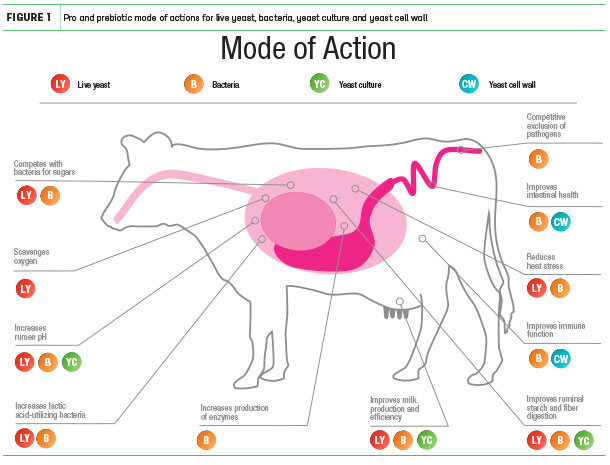Because prebiotics and probiotics are not one-size-fits-all solutions for the challenges faced on dairy farms, it is necessary to understand the difference between product types and modes of action to tailor-fit solutions for particular situations. Making informed decisions will ensure products are effectively used and bring the greatest benefit to your herd.
Prebiotics
Prebiotics fall into a broad, poorly defined category that includes many yeast-derived products. The most-agreed-upon definition, from 1995, suggests a prebiotic is “a nondigestible food ingredient that beneficially affects the host by selectively stimulating the growth and/or activity of one or a limited number of bacteria in the colon and thus improves host health.”

Yeast culture and yeast cell wall are types of prebiotics commonly fed to dairy cattle. Yeast culture is dried yeast along with its growth media, which provides a source of nutrients for rumen bacteria, promotes growth of beneficial bacteria, increases volatile fatty acid production and improves production efficiency in lactating dairy cows. In addition to these responses, dry matter intake (DMI) in early lactation cows may increase when yeast culture is included in the diet.
On the other hand, yeast cell wall products have a high concentration of beta-glucans and oligosaccharides, including mannan oligosaccharide, though this number can vary depending on the specific type of yeast and processing method. Mannan oligosaccharides and beta-glucans can bind with pathogenic bacteria via a specific type-1 fimbria (specific finger-like binding regions) in the lower gastrointestinal tract of the dairy cow, preventing pathogen adherence to cells. Bacteria do not cause damage if they cannot bind to host cells; therefore, this binding mechanism reduces pathogenic infections.
Some yeast cell wall products are also effective toxin binders, particularly for aflatoxin, ochratoxin and zearalenone. Due to variation between strains and different processing methods, yeast cell wall products vary in their effectiveness for binding both pathogenic bacteria and toxins. Understanding the challenges present in individual herds is essential to making the best product decisions.
Probiotics
The probiotic category has greater product diversity, as it includes both live yeast and live bacteria. According to the World Health Organization and the Food and Agricultural Organization of the United Nations, a probiotic is defined as “live micro-organisms which, when consumed in adequate amounts, confer a health effect on the host.”
Live bacteria can improve ruminal health by competing with rumen bacteria for sugar, improving ruminal starch and fiber digestion, and increasing enzyme production, thereby improving milk production efficiency and maintaining rumen pH. Additionally, live bacteria can stimulate the immune system’s sensing cells (dendritic cells) to interact with immature T cells (immune cells involved in targeted pathogen defense).
This interaction induces T cell differentiation and cytokine (small proteins that mediate cell-to-cell interactions) production, thus improving a cow’s adaptive immune response to bacterial challenges. They can also produce substances called bacteriocins that promote gastrointestinal health by inhibiting growth of pathogenic bacteria. Live bacteria can improve intestinal tissue health and assist in mitigating “leaky gut” by strengthening interactions between mucosal cells and tight junction proteins, and producing a beneficial biofilm that coats the lining of the intestines.
Live yeast improves milk production, feed efficiency and component production through a variety of mechanisms. Ruminal fiber-digesting bacteria are extremely sensitive to oxygen and low pH. Live yeast can scavenge oxygen that enters the rumen when cows swallow, providing a better environment for the fiber-digesting bacteria to survive and thrive. In addition, live yeast stimulate lactate-utilizing bacteria in the rumen, which can help reduce the risk of sub-acute ruminal acidosis (SARA) and maintain optimal rumen pH.
These mechanisms combine to increase fiber-digesting bacteria, increase volatile fatty acid production and improve microbial protein production. As with yeast cell wall products, live yeast can also bind pathogenic bacteria (such as E. coli and Salmonella) and mycotoxins (including vomitoxin, aflatoxin, ochratoxin and zearalenone). However, it is important to note that, similar to yeast cell wall, pathogen and toxin binding varies depending on the strain of live yeast fed.
Combination products
There are numerous products on the market that include combinations of many of the individual ingredients listed above, in addition to other ingredients such as enzymes, clays or zeolites. Enzymes are a valuable addition to many prebiotic- or probiotic-based combination products, as they can be effective at lower pH levels stimulating increased rates of ruminal nutrient digestibility, particularly for starch and fiber. Zeolites and clays bind toxins with varying affinities and can complement the mycotoxin binding of yeast cell wall products to mitigate the effects of toxins in dairy cows. When evaluating combination products for implementation on farms, feeding rates and quality of the individual ingredients must be considered.
Conclusions
Economic returns on prebiotic, probiotic and combination products can range from 4-to-1 to 10-to-1 or higher. The marketplace is flooded with products; therefore, evaluation and selection of appropriate probiotics, prebiotics or combination products is critical.
Strain selection and manufacturing processes can drastically alter the efficacy of these ingredients, and it can be difficult to conduct standard quality control methods to ensure viability of probiotics. As such, it is necessary to have confidence in the products you select, regarding both ingredient quality and potential economic and health returns for the dairy.
All cows, calves and heifers can benefit from a probiotic or prebiotic feeding program, assuming the products selected have been thoroughly evaluated and proven in a controlled research environment and have been chosen to meet the specific needs of the herd. ![]()
References omitted but are available upon request. Click here to email an editor.

-
Sarah Stocks
- Technical Services Manager
- Papillon Agricultural Company
- Email Sarah Stocks






